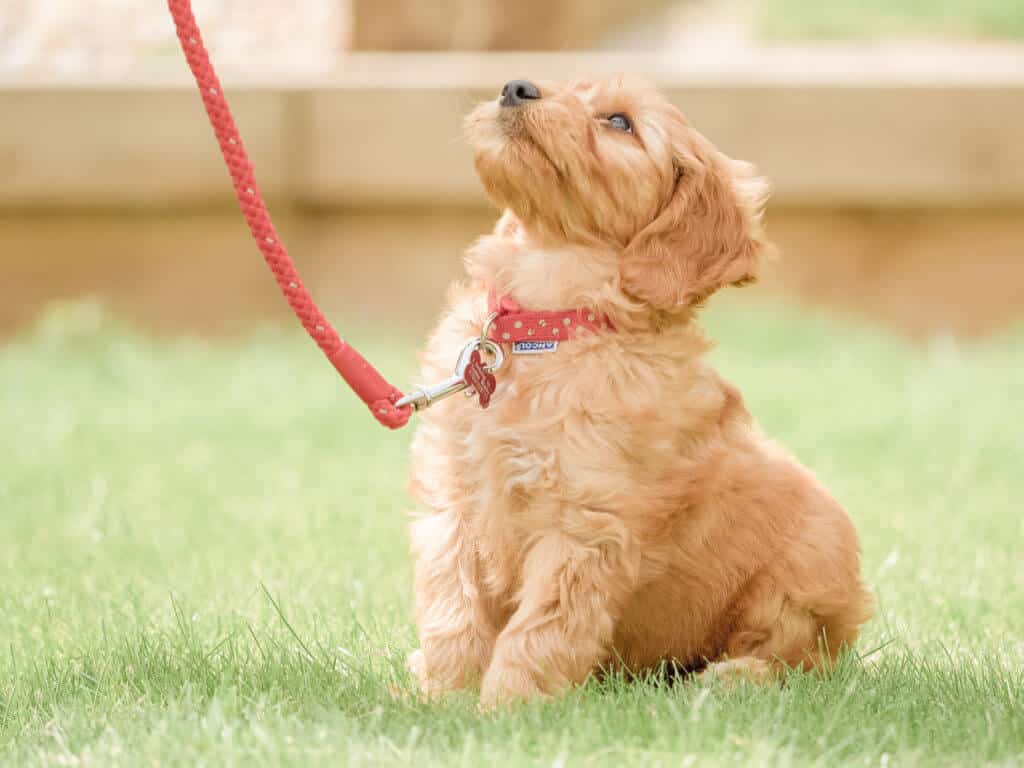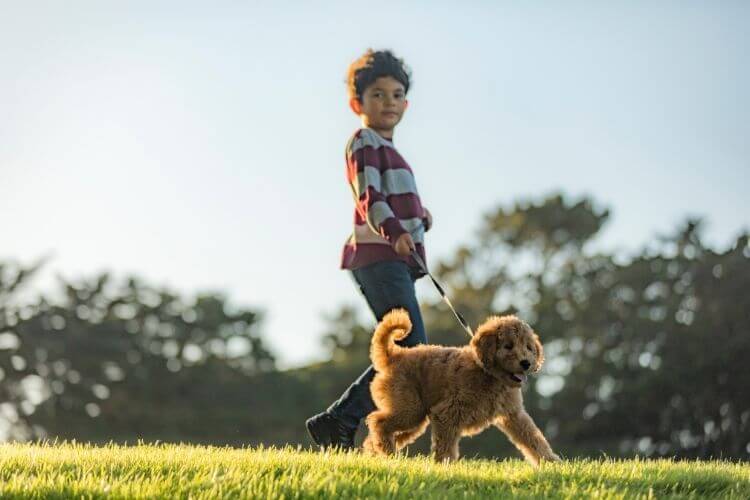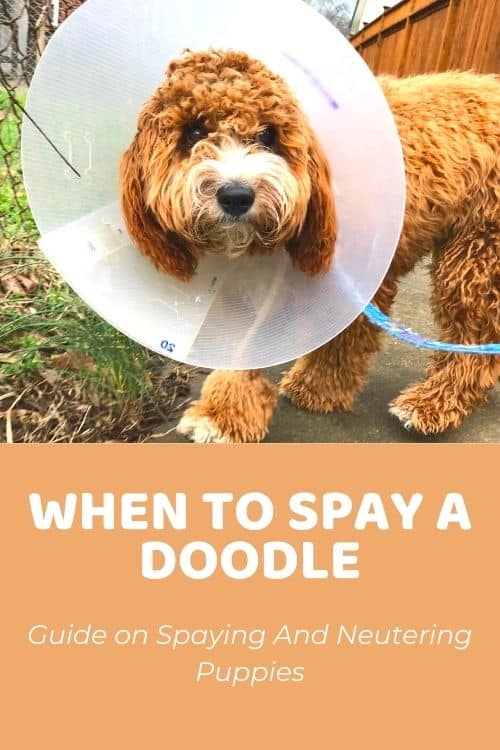Learning how to leash train a dog is an important skill to master for both you and your Dood! Here’s what you need to know about leash training, and how to get started.
Have you ever had a sore arm after walking the dog? When Doodles reach their full size (and even before then!), it can be a real workout keeping them under control. With so much energy and playfulness, they love walks, but sometimes their enthusiasm can be exhausting for their owners.
Doodles are certainly a smart breed and good for beginners, but there’s still some work that goes into their training. Learning how to leash train a puppy is an important step in having an obedient and easy-to-care-for dog.
This guide will cover how to leash train a dog and what you can expect from your Doodle. I’ll also share the best walking products and a step-by-step guide on how to get leash training started. If you follow all the steps, you will establish yourself as the pack leader in no time.
Table of Contents
- Why Should You Leash Train A Dog?
- What to Expect When Training Your Doodle
- The Best Type of Leashes
- How To Leash Train A Dog
Why Should You Leash Train A Dog?
When it comes to training your dog how to walk with a leash, there are a ton of benefits. These are not only for you, but for the dog as well. Having control over a puppy or a young dog while being trained outside is a must.

Dogs will continue to do what you let them practice. This is why it is so important to teach them to walk without pulling. Avoiding this bad habit by teaching them how to walk on a leash will prevent them from continuing unwanted behaviors.
Safety is also a big factor. It can prevent your pup from suddenly running in the road or tugging in the wrong direction, or accidentally getting caught in something they shouldn’t. Proper leash training will also prevent them from chasing or scaring animals, children, or people who are afraid of dogs.

Have you ever had your dog do their business on someone’s lawn…right in front of them? It can be very embarrassing (or just a hassle) when your dog goes to the bathroom in the wrong place. Proper leash training can help to prevent this.
Of course, convenience for the doggy parent is a huge positive, too, when your dog is comfortable on a leash. They can safely be tethered while you run in and grab a coffee, and will walk easily for others. This makes it simple for a dog walker or friend who may be walking them while you’re away.
What to Expect When Training Your Doodle
Without a doubt, Doodles are one of the most energetic dogs. It’s one of the main reasons we love them and one of the biggest reasons they should go on walks. Walks will help to tire out your Doodle, but it must be done right – otherwise, they end up tiring you!
Doodles will bounce off your energy. If you find them being too rambunctious before a walk, try to keep the atmosphere calm. (Even if they are being super cute!)

It’s important to start training immediately so you can set boundaries as soon as possible. Spend plenty of time with your young Doodle, as dogs need to trust their owners before they begin listening. Then, remember to start off with the basic commands before you research how to leash train a dog.
Doodles are very friendly, meaning you can expect them to want to approach and interact with other dogs and people. It’s up to you whether or not you allow this, but always make sure it’s your decision, not your dog’s.
The Best Type of Leashes
Before you get started walking, you have to make sure you have the right equipment to begin. Talking a walk down the leash aisle at the pet store can be very overwhelming. There are a ton of options and many leashes have different uses for different temperaments.
Before buying a leash, consider its purpose, material, length, and attachment style. For leash training your Doodle, there are some leashes that work better than others.
A standard leash like this one is good for training your dog. While training, you want a leash that is on the shorter side, from 4-6 feet. Avoid retractable leashes as they actually train your dog to pull on the leash.

Collars are not advised while training as it also can encourage pulling and can cause stress to the dog’s neck. Instead, use a harness – it will give you more control over a dog while it still needs guidance. If you’re unsure about what size of harness to get for your puppy, check out our puppy growth chart. It’ll help you figure out what size would work best.
You can also consider using a leader leash like this one. This is different from a traditional harness as the leash attachment is under the dog’s chin rather than on its back. This helps you assert control by keeping the dog at your side rather than letting them push ahead.
As your dog learns and is getting better trained, consider a leash that attaches to you around your waist. This lets you have two free hands and offers more balance. Your hands can be used to dispense treats or help to direct the dog if needed. This is also great for runners who like to bring their dog along with them.
How To Leash Train A Dog
Learning how to leash train a dog takes a lot of patience. Don’t expect anything to happen overnight! Begin with these steps to get started and after practicing, you will find doggy success.
Tire Them Out
There is more to walking a Doodle than simply grabbing the leash and heading out the door. Since they are such an energetic breed, it’s a good idea to get them a little tired before the walk. Having an untrained dog full of energy on a leash is just begging for trouble.
Exercise your puppy with play out in the backyard beforehand. Toss a ball back and forth and practice fetch. Before throwing the ball, have your dog sit – this allows them to play and get their minds rolling. They know they are rewarded by good behavior when you toss the ball.
Before the Walk
Now, you want to wait for your puppy to be calm. Oftentimes, dogs will learn the word ‘walk’ or get excited when they see the leash. You want your dog to be completely calm before you leave the house.
Don’t put the leash on while they are excited. Once you grab the leash, wait for them to calm down – this may take a while, so be patient. Feel free to put the leash back, wait until they are calm, and then try grabbing it again. It’s normal to need to repeat this a few times before they learn.
Once you’ve left the house, maintain this required calm. If they get amped up again the second they are outdoors, only take them as far as the sidewalk. Then, bring them back inside again. Your puppy needs to learn that calm energy is the right walking energy.
Master the Loose Leash
The ultimate goal is to have your walking buddy at your side with a loose leash. Yanking and pulling is the main thing you are trying to prevent. You are the pack leader and it is important to establish yourself as such while walking.
The first step to training is to always keep a short leash. This means your dog cannot be ahead of you or go where they aren’t allowed. A leash should be short enough that your arm, wrist, and elbow are relaxed. You shouldn’t have to raise your arm to hold your leash.
If your dog begins to stray or starts to sniff, first try sending signals through the leash with gentle taps. This is you reminding them that straying is not allowed. Never yank or pull the dog.
If they aren’t picking up your message, completely stop walking and plant your feet on the ground. Do not move until they come back and the leash loosens up a bit. Once they are waiting and calm, start walking again. Soon they will learn that they can only walk when the parent is walking in their direction of choice.
While training, don’t let them sniff whenever they want to. Reward them when they are being calm, but don’t overload them with treats. Praise works just as well most of the time!
Start your training off in familiar areas like your home or yard. Practice walking through the lawn on a leash. Then head to the front yard, up and down the street or a short loop. Then, graduate them to a larger walk – baby steps are important.

Practice Turning
Dogs need to learn that they can only go in the direction their doggy parent is taking them in. A good way to instill this in your dog is by practicing turns. Do this activity in a familiar area to get them started.
To practice your turns, you want to walk normally with your dog at your side on a short leash. Next, gently step in front of the dog by turning, blocking them with your leg. You will guide them and reverse directions by turning the dog’s head.
Practice turning in front of your dog up and down the sidewalk. You will soon notice that your dog will follow your lead no matter which direction you go.
Remember, all kinds of obedience training will take a while, even for a smart breed such as a Doodle. Leash training won’t happen in under a month, but after plenty of practice, your dog will be a perfect walker soon enough.
Let Them Have Fun
As Cyndi Lauper would say, “Dogs just want to have fun.” Always remember that walks are more for your dog than they are for you. Having a controlled walk lets them work both mentally and physically. However, there need to be moments where the dog is allowed to roam a bit.
Leash training will help the owner maintain overall control. But, you also need to make sure you give your pup time to do their doggy stuff. This means letting them go to the bathroom and sniffing around.
Dogs are curious animals by nature and it’s important that you allow them to also have fun when you take them on a walk.
Difficult Dogs
Sometimes, no matter how much you try, there are always going to be some difficult dogs. The best advice here is perseverance. Training your dog will definitely test your patience, but the worst thing you can do is give up.
Start off small. If your dog can’t handle walks, then keep them short and to the point. The fewer distractions the better, so avoid walking during busy parts of the day if possible. Don’t head out on long walks but instead, do multiple short walks throughout the day.
Most importantly, be consistent. Ensure that you are following and teaching the same rules and your dog will eventually catch on.
Of course, any food-motivated dog can benefit greatly from some treats. Be picky when giving out treats and reward them only when they are calm and looking at you. This is especially important if your dog gets too excited by an approaching dog or person.
In the end, sometimes you may need professional help. Find a local dog trainer or look for online classes. Baxter and Bella is an online puppy school that allows you to train your puppy from home at your own pace. This is great if you have a busy or irregular schedule. Or, even for those who find themselves in an area with too far a commute for puppy classes.

Need help with training?

Use our discount code: DOODLEDOODS at checkout for an instant 25% off of BAXTER & BELLA, The Online Puppy School – an incredible value on their lifetime membership!
Learn More About BAXTER & BELLAThis guide on how to leash train a puppy is a great place to get started. If you haven’t leash trained your Doodle yet, give these tips a try! You’ll have a great walking companion before you know it.
Learn How to Care for Your Doodle Puppy!

Perfect for first-time Doodle parents, get ALL your questions answered, including questions new Doodle parents don’t even think to ask.
Plus, get $700 worth of Bonus Materials for FREE, including:- Doodle Parenthood Community and Support Group ($190 value)
- Doodle Puppy Growth Tracker ($20 value)
- EMERGENCY Cheatsheet: When To Call The Vet Immediately ($50 value)
- HELP! Button ($145 value)
- And SO MUCH MORE!










